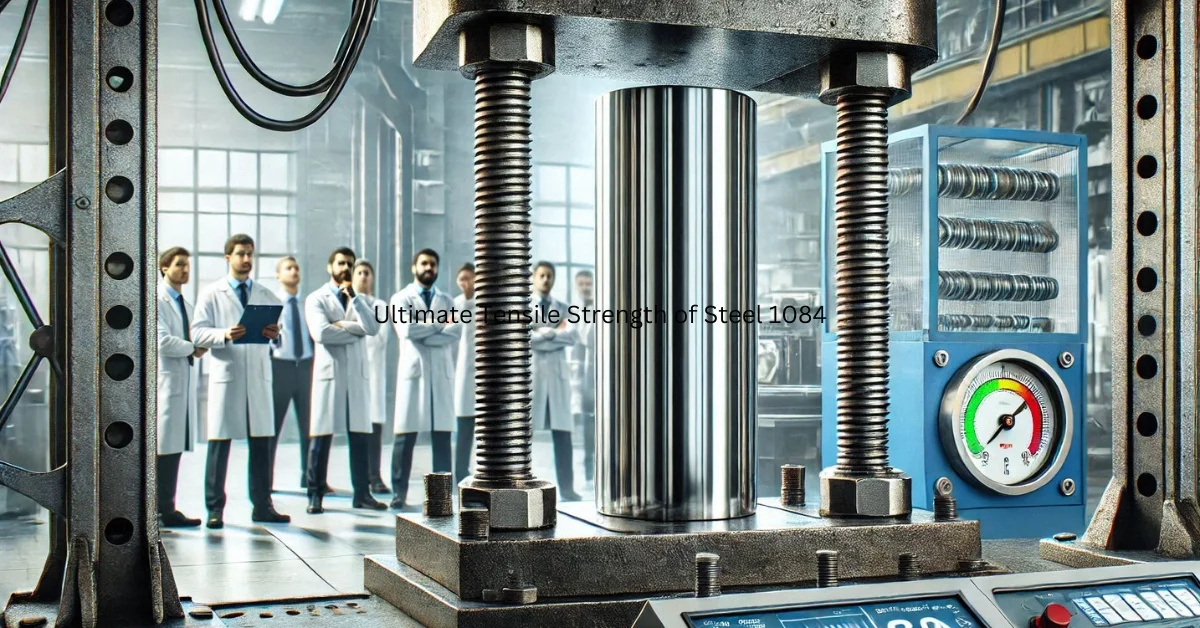When it comes to choosing materials for tools, automotive parts, or structural components, understanding their mechanical properties is essential. Among these properties, the ultimate tensile strength (UTS) is a key factor that helps determine how well a material performs under stress. Steel 1084, a high-carbon steel, is a popular choice because it provides an excellent balance between strength and toughness. In this article, we will dive deep into the Ultimate Tensile Strength of Steel 1084, covering its composition, mechanical properties, applications, and much more.
Chemical Composition of Steel 1084
Steel 1084 gets its unique properties from its specific chemical composition. Here are the main elements found in it:
- Carbon: 0.80–0.93% – This high carbon content increases the steel’s hardness and strength.
- Manganese: 0.60–0.90% – Manganese enhances the steel’s tensile strength and wear resistance.
- Trace Elements: Small amounts of phosphorus and sulfur improve machinability without affecting strength significantly.
This composition makes steel 1084 highly suitable for heat treatment, allowing users to achieve the perfect mix of hardness and toughness for different needs.
Mechanical Properties of Steel 1084
Steel 1084 is known for its impressive mechanical properties, particularly its UTS. Let’s look at some of its key characteristics:
- Ultimate Tensile Strength (UTS): 820–930 MPa (119,000–135,000 psi). This means it can handle significant stress before it breaks.
- Yield Strength: ≥452 MPa (≥65,500 psi). This is the point where the steel starts to deform permanently under stress.
- Hardness: Brinell Hardness is approximately ≥241, which helps it resist wear and tear.
- Elongation at Break: ≥10%. This shows how much the steel can stretch before it breaks, reflecting its ductility.
- Modulus of Elasticity: Around 200 GPa (29,000 ksi). This indicates the stiffness of the material and how much it will deform under load.
These properties make steel 1084 a versatile and reliable choice for many industries.
Factors Influencing UTS in Steel 1084
Several factors affect the UTS of steel 1084. Here are some of the most important ones:
- Heat Treatment: Processes such as annealing, quenching, and tempering can dramatically change the tensile strength.
- Manufacturing Techniques: Techniques like forging and rolling improve the grain structure of the steel, making it stronger.
- Alloying Elements: The amount of carbon and manganese in the steel directly impacts its strength and durability.
Knowing these factors can help users optimize steel 1084’s performance for their specific needs.
Comparison with Other Steel Grades
Steel 1084 is often compared with other high-carbon steels. Here’s how it stacks up:
- Steel 1080: Has slightly lower UTS (770–870 MPa), but is still used for similar applications.
- Steel 1095: With more carbon, it is harder and more wear-resistant but less ductile than 1084.
- Steel 5160: An alloy steel with added chromium. It offers excellent toughness and fatigue resistance.
These comparisons highlight the balanced properties of steel 1084, making it a preferred material for applications that need both strength and flexibility.
Applications of Steel 1084 Based on UTS
The high UTS of steel 1084 makes it suitable for a wide range of applications, including:
- Tool Manufacturing: Steel 1084 is a popular choice for making knives, blades, and cutting tools due to its hardness and ability to hold a sharp edge.
- Automotive Components: It is commonly used for making springs and other high-stress parts that require durability and strength.
- Structural Applications: In construction, it is used for load-bearing components where reliability is critical.
Its versatility and reliability ensure its popularity in various industries.
Advantages and Limitations of Steel 1084
Advantages
- It provides an excellent combination of strength and ductility, making it ideal for many uses.
- The steel is highly responsive to heat treatment, allowing users to customize its properties.
- It is affordable and readily available, making it accessible for professionals and hobbyists alike.
Limitations
- Steel 1084 is prone to rust if not properly maintained, as it lacks corrosion resistance.
- Without precise heat treatment, it may become too brittle or fail to reach its full potential.
Understanding these advantages and limitations helps users get the most out of steel 1084.
Testing Methods for Determining UTS
To measure the UTS of steel 1084, standard testing methods are used:
- Tensile Testing Procedures: A sample of the steel is stretched until it breaks. This measures its ability to handle stress.
- Sample Preparation: Proper preparation ensures accurate results. This includes shaping the sample and polishing its surface.
- Interpreting Results: Stress-strain curves generated during the test provide valuable information about tensile strength, yield strength, and elongation.
Heat Treatment Techniques to Optimize UTS
Heat treatment is one of the most effective ways to modify the UTS of steel 1084. Here are the main techniques:
- Annealing: Heating the steel and then cooling it slowly refines its grain structure, making it softer and more ductile.
- Quenching: Rapid cooling after heating increases hardness and tensile strength but can reduce ductility if not tempered.
- Tempering: Reheating the steel to a moderate temperature after quenching helps balance hardness and toughness.
These techniques allow users to tailor steel 1084 to meet specific requirements, whether for cutting tools or structural components.
Conclusion
Ultimate Tensile Strength of Steel 1084, along with its other impressive mechanical properties, makes it a top choice for a variety of industries. Its combination of strength, ductility, and affordability makes it ideal for knife-making, automotive parts, and structural applications. By understanding its properties, influencing factors, and the impact of heat treatment, users can maximize the potential of steel 1084 for their projects.
FAQs
What is the ultimate tensile strength of steel 1084?
Steel 1084 has an ultimate tensile strength ranging from 820 to 930 MPa (119,000 to 135,000 psi).
How does heat treatment affect steel 1084?
Heat treatment processes like quenching and tempering can increase tensile strength and improve toughness, depending on the method used.
What are the common uses of steel 1084?
Steel 1084 is widely used for knives, automotive springs, and structural components due to its strength and versatility.
How does steel 1084 compare to other high-carbon steels?
Steel 1084 offers a good balance of strength and ductility compared to harder but less flexible steels like 1095.
Is steel 1084 resistant to rust?
No, steel 1084 is not corrosion-resistant. Proper maintenance, like oiling, is needed to prevent rust.



